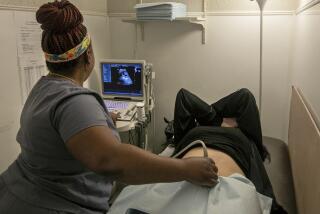Difficult Decisions for Premature Babies’ Parents
- Share via
DALLAS — It seemed an absurd question to ask a woman who had just spent nine hours in the emergency room’s waiting room, bleeding, throbbing and praying that the twins inside her weren’t already dead.
She recalls the doctor’s words this way: “If your babies come out, you know, do you want us to do all we can to save them . . . ?”
For a moment, Denetta Williams forgot that she was only 23 weeks pregnant. She forgot that she had waited so long in the waiting room that it was probably too late to stop the labor.
“What kind of question is that?” Williams asked. “Act like it was your baby. You’d want your baby to live, so do whatever you can to save mine.”
But the moment she saw her baby girls, each weighing just over a pound, she understood the doctor’s question.
“I broke down crying,” Williams said. “They didn’t even look real. They didn’t even look like people.”
Low birth weight babies--those born at less than 5 1/2 pounds--accounted for 7.6% of all 1998 births, according to the Annie E. Casey Foundation’s recent Kids Count study.
These babies face many potential health problems, including asthma, visual deficits, skin problems, speech delay, feeding disorders, ear infections, even cerebral palsy.
Two weeks after her delivery, Williams buried one of her daughters.
The other girl, Jaclavia Rider, hung on. The doctors said she would be blind; it looked as if she would be mentally retarded and physically disabled.
When tiny Jaclavia stopped pushing air through her narrow windpipe, when her brain filled with fluid and her eyes were rolling and the left side of her body wouldn’t move, her mother says she started doubting how she had answered the doctor’s question.
Still, she kept pushing.
The doctors put a shunt in Jaclavia’s brain and a plastic windpipe in her throat, and the infant began to blossom.
Williams talks about the experience from a hospital room at Children’s Medical Center of Dallas, where Jaclavia has been treated since being born in a different hospital.
She and Jaclavia, now 2, are waiting for the silly juice, the anesthesia, to arrive.
“This is the easy part,” Williams says, watching her daughter play with oversized blocks. The toddler’s sight is fine now and she is mentally up to par with children her age, though her motor skills are still lagging.
In a few minutes, doctors will perform surgery on Jaclavia for the 10th time. They’ll take cartilage from her rib to construct a new windpipe in place of the plastic one.
The Low Birth Weight Clinic at Children’s has eased at least some of Williams’ burden.
“It’s no new technology,” says pediatrician and neonatologist R. Sue Broyles of the clinic. “It’s really just being available to these families.”
The clinic loses about $1,000 on every baby it accepts. Jaclavia is proof of its triumphs.
The clinic’s preemie wing is proof of the struggles ahead.
Little limp bodies lie growing, or dying, in a dark garden of potential children. They lie in wombs of white towels and blankets, under skies of clear plastic to protect their grape-peel skin from drying like raisins.
They’re tended by warm fingers of nurses and lulled to sleep by the purring of machines that keep them alive.
Now, Williams is waiting as the nurses wheel Jaclavia out of the operating room.
Unfazed by the drugs, the little girl with braids and one pigtail sits straight up and looks for her mother.
More to Read
Sign up for Essential California
The most important California stories and recommendations in your inbox every morning.
You may occasionally receive promotional content from the Los Angeles Times.










